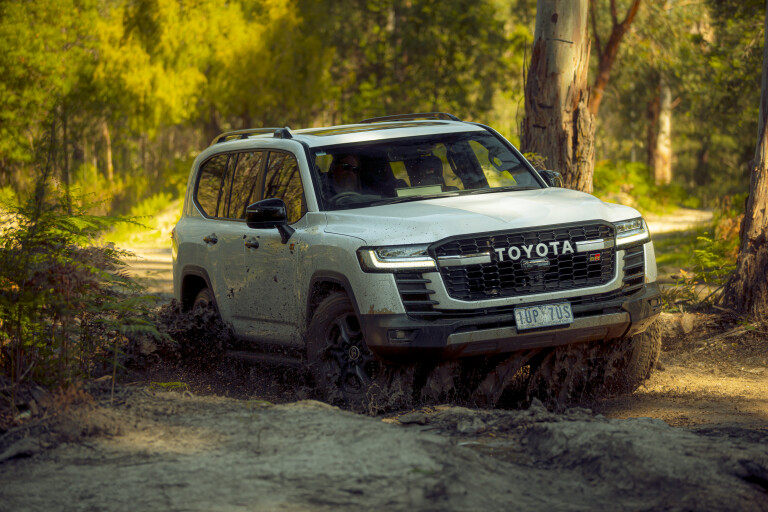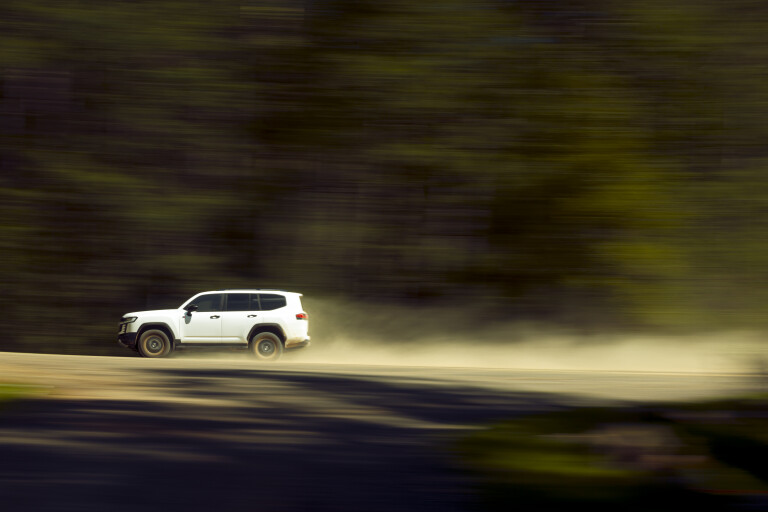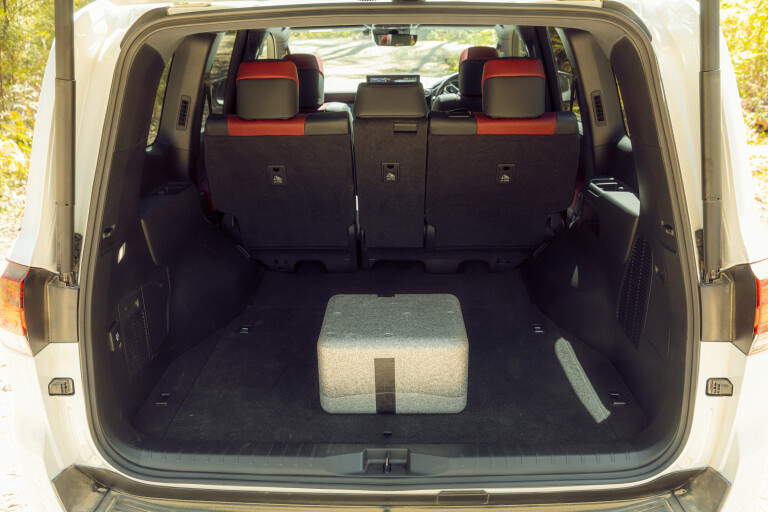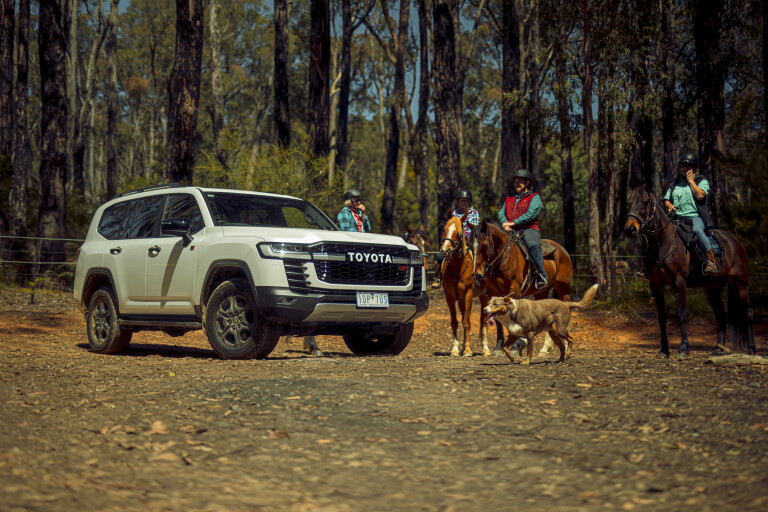
Things we like
- Smart off-road tech
- Lighter and stronger chassis
- Interior bling and comfort
Not so much
- Single tailgate
- Lowest payload of the six models
- Fuel capacity drop from 138 to 110 litres
IT’S been a long time coming, 14 years in fact since the launch of the 200 Series, and even after its eventual launch Toyota’s 300 Series LandCruiser is still a hard vehicle to get in to.
While semi-conductor shortages have delayed production and limited supply to customers, we’ve managed to nab an LC300 for a few days to test its off-road mettle.
As it is marketed as the more off-road focused model in the six-variant LC300 range, we’ve gone for the GR Sport model which, along with the range-topping Sahara ZX, is new to the nameplate. What makes the GR Sport the most off-road capable LandCruiser variant is the inclusion of front and rear locking differentials as standard and the addition of E-KDSS which is the latest generation of Kinetic’s clever suspension system.
The killer is that the GR S is the only model to get this off-road hardware and you can’t option factory lockers or KDSS in to the lower-grade models.
The problem with the GR S is that, at $137,790 it’s the second most expensive model in the range, only beaten by Sahara ZX which adds another $1000 to the base price. The GR S comes with the equipment levels to match that price but all that kit adds weight, meaning that the GR S has the lowest payload in the range with 650kg available.

POWERTRAIN & PERFORMANCE
UNDER the Cruiser’s new aluminium bonnet is an all-new 3.3-litre twin-turbo V6 diesel engine. The V8 is gone but this engine makes more power and torque than the old 4.5-litre bent eight. The 700Nm of torque and 227kW of power are on tap under the go pedal and it propels the big Cruiser along swiftly when you put your foot down.
The F33A-FTV engine employs what is known as a ‘Hot-V’ design. This means that the exhaust manifolds and the turbochargers are mounted in the 90° V between the cylinder heads and the intake manifolds are on the outside of the engine. This helps to make the engine more compact and puts the turbochargers closer to the exhausts ports to reduce lag and increase efficiency.
With all that heat now at the top of the engine, Toyota has had to do away with the top-mounted intercooler as used on previous LandCruisers and moved them up behind the grilles, under the headlights. I say them, as there are two of them and they are now a fluid-to-air design so they should be more efficient.

The problems of this set-up, particularly for off-roaders, is that they are more vulnerable to damage being mounted right up the front of the car and are more complex in design introducing another coolant system to the powertrain.
The engine is backed by a 10-speed automatic transmission and before your ask; no, it does not automatically shift through to top gear under normal highway cruising conditions. I found that cruising at 110km/h and moving the shift lever across the manual mode would shift it back a ratio to seventh gear and tapping it though to 10th you could get it to cruise at around 1300rpm. Shift back to automatic and the revs pick up as the transmission goes back to eighth for easy cruising.
I don’t see this as a problem. The transmission is programmed to keep the engine in its optimum rev range for the speed, load and conditions the car is operating under. I’m pretty sure that if the engineers thought they could make it more efficient by allowing it to shift through to top at that speed they would have, in their never-ending quest for efficiency and fuel economy.
Speaking of economy, the 300 is officially rated at 8.9L/100km on the combined cycle and we recorded 13.62L/100km during our stint of suburban, highway and off-road driving. The old 1VD-FTE engine was never particularly efficient and this new-tech V6 combined with the 10-speed auto should prove much more frugal in real-world conditions.

ON-ROAD RIDE & HANDLING
THE LC300 rides on Toyota’s new TNGA chassis which it shares with the Tundra pickup truck in the USA that was launched around the same time as the new Cruiser. It’s still a body-on-frame design but now employs more high-strength steel in key areas to improve stiffness, while using aluminium in some suspension components to reduce weight.
The suspension is a double wishbone, coil sprung independent set-up at the front and live rear axle at the back, located by multi-links and riding on coils.
The GR Sport and Sahara ZX Cruisers get variable dampeners that allow you to select comfort, sport or sport+ settings to suit your driving preference and style.

The GR Sport’s E-KDSS system works on the front and rear sway bars to lighten the tension on them when driving at low speeds off road, and tighten them up for firmer body control at higher speeds on road. The system is a further development of the old KDSS to now automatically disconnect the sway bars when required off road to give the most axle articulation.
All that kit delivers a ride and handling characteristic that is still instantly recognisable as LandCruiser. It’s soft and supple, soaking up road bumps, and pitches and wallows when pushed hard. Even in the Sport modes the handling is still soft and the LandCruiser has no sports car pretensions.
It’s a vehicle that’s designed to soak up anything the road can dish up to it while covering hundreds of kilometres per day and it does that very well.
OFF-ROAD
THE LC300’s four-wheel drive system carries over a full-time, dual-range set-up with a locking centre differential. As mentioned, the GR S also gets front and rear locking diffs and is the only model in the range to get them. When not using the diff locks, the car still has a perfectly calibrated electronic traction control system (ETC) and the refinements to the Crawl Control over the previous generation are exceptional and make it much more usable.
We pointed the GR S LandCruiser up a particularly steep and rocky climb in the bush near Toolangi (Vic), which we thought would challenge it on its standard highway tyres. It is a hill we wouldn’t attempt in any standard 1-tonne 4x4 ute or the wagons built on those platforms.

With the diff locks engaged, it walked up the first section far easier than expected and didn’t spin a tyre at all. The E-KDSS system gives the GR Sport 715mm of wheel travel which is 46mm more travel than the old 200 Series when equipped with the previous generation KDSS. This kept the tyres on the ground for maximum traction.
I disengaged the front locker as I progressed up the hill and a few rock steps presented what could have been more of a challenge. Again, the Cruiser crawled up with relative ease, just scrabbling for front grip to get up the bigger steps and only lightly scraping one of the side-steps.
The hill got steeper and the rock steps bigger, but there was no turning back at this point. I haven’t liked using Crawl Control or Hill Descent systems in the past but hit the button to switch CC on it lowest of five speeds and selected the Rock setting in the terrain selector (MTS).

Employing larger pressure accumulators in the system has made CC much quieter and smoother than it was in past models and allowed the car to crawl slowly up with no driver input on the accelerator pedal, just steering the Cruiser to the best lines. You can feel the system applying minute amounts of drive to the axles while braking individual wheels to gain the most traction. It works brilliantly!
I might not have liked such systems in the past but now that Toyota has refined it, I have to say the Crawl Control is exceptional both going up and down hills and will be of particular benefit in the lower grades of 300 Series that don’t have diff locks.
I still prefer to use the lockers and my own inputs but this system makes it easy for anyone who might feel intimidated by a situation they have got themselves in to. I was very impressed with the performance on this hill, considering the road tyres on the car.

CABIN & ACCOMMODATION
SLIP inside the GR Sport and you see why this is one of the more expensive LC300 models. Heated and cooled power-adjustable leather seats, power sunroof, plenty of bling, big configurable touchscreen that finally includes Apple CarPlay and Android, heads-up speed display for the driver, wireless phone charging and a drink chiller in the console are all fine appointments you’ll find in a luxury model.
The GR S only has five seats, while other models in the range can have seven. This is as much to do with payload as anything, as the weight of the third-row seat plus passengers wouldn’t leave you with much. The lack of a third-row seat does leave plenty of space for cargo and there are four tie-down points here and a 220V-100amp power outlet, but no 12V outlet. I always like at least one 12V outlet here for powering a fridge and maybe some camp lights, while I’ve never gone looking for a household-style power plug in a car for anything during all my years of travels.

The old two-piece tailgate is gone and the now one-piece tailgate opens upwards.
The split tailgate design that used to be on LandCruisers and Land Rovers was fantastic as it gave you a tailgate which you could easily use as a table when prepping quick lunch on the road or simply a seat. As it was on the Land Rovers, it has been deleted to save weight but I wonder how much weight could be saved if the tailgate wasn’t powered. It is a feature that will be missed on the Cruiser wagon.
The seating position is lower than it ever was in the previous model and this gives the impression of more space even though it’s really not much, if any bigger than an LC200.
At least I’m looking out the centre of the windscreen now and not through the top of it. The steering column is power adjustable for reach and height.

There’s plenty going on around the centre of the dash with lots of buttons but unfortunately, no easy-to-use dials for volume or station tuning.
One of the first things I found when driving the Cruiser was that whenever I looked to the dash to adjust something, I was blinded by the glare coming back at me from the silver switch gear. It only happens when the light hits them in such a way, but it makes all the black buttons extra dark so you can’t quickly focus on the labels on them. It’s poor design but hopefully will becomes less problematic with more use and familiarity.
Like the 200 Series, the cabin of the 300 presents a large and comfortable place to make long trips easy. A sliding second-row seat to give more rear-seat leg room would be nice but isn’t available, and some tall adult passengers might not find the back seat too comfortable.

PRACTICALITIES
AS a five-seater, the GR S has plenty of luggage space in the back but owners will have to be wary of how much they carry, especially once they have fitted some heavy accessories or have a bit of weight on the tow ball.
The GR Sport has a 650kg payload, which is the lowest in the model range, while the entry-level GX model has the highest at 785kg. Towing is rated at 3500kg and having pulled a 3000kg trailer behind a 300 on another occasion, I have to say it does it easily.
Tyres on the GR Sport are 265/65R18s which look small on it, while 17-inch wheels are available on the GX and at the other end of the range, the Sahara ZX wears 20s. There’s no reason you couldn’t fit any factory wheel 17-inch or above to any of the LC300 models to get the right tyres for what you do with the car. The 300 Series has reverted to six-lug wheels after the 100 and 200 Series vehicles had five-lug.

The standard fuel capacity has dropped from 138 litres to 110, with 80 in the main tank and 30 litres in the sub-tank.
As it was on the 200, the tow bar is an integral part of the chassis and you just need to remove the panel in the bumper to insert the hitch and tow tongue. For the 300, Toyota has now incorporated the towing wiring in to the factory harness, simplifying installation.
The engine bay doesn’t leave any obvious space for a second battery so the aftermarket guys will have to get creative to make that fit, while the air intake breaths through the near-side inner guard.
Toyota has upped its game for genuine accessories and offers a choice of steel or aluminium bullbars, nudge bars, an LED light bar, roof racks, a Warn winch, underbody protection, rated front recovery points, a rear recovery hitch, and a raised air intake which is standard on the GX model.

With the added vulnerability of those intercoolers up the front of the car, we’d recommend the fitment of a bullbar to any LandCruiser travelling in regional or outback areas to protect them as well as the car’s regular cooling system. A ’roo strike on either side of the front of the car could easily take out one of the coolers and leave you stranded.
With the expected popularity of the 300, like any LandCruiser, you can bet the aftermarket brands will also deliver an extensive range of accessories, but you should also question the ability of any product to work with the safety systems on any modern car.
The radar and camera systems will provide challenges for the equipment designers. Thought also needs to be given to the GVM and payload when fitting any accessories.
SUMMARY
TOYOTA has raised the bar with the LandCruiser 300, although it’s only incremental. In its typical manner, Toyota only does as much as it has to to stay ahead of the pack and with no serious competition in terms of vehicle sales, it hasn’t revolutionised anything here. What it has done is refined the well-proven LandCruiser formula to deliver a car that is more efficient, more capable and easier to drive.
The inclusion of the GR Sport model with its lockers and E-KDSS is to be commended as it creates a luxury 4x4 with capability we doubt any could match. The L663 Land Rover Defender would be the best comparison, as well as its traditional rival the Nissan Patrol.
We’d love to see a model that delivers more of what 4WD enthusiasts would really like. That is, a lighter and cheaper GX or GXL model with the factory lockers and E-KDSS. By not offering this, Toyota has left a huge opportunity for the aftermarket to fill that void. The $30K saved off the price of the GR S would buy a lot of accessories to build a supreme touring wagon.
In standard guise, the GR Sport is a supreme vehicle and will continue the marque’s dominance of the large 4x4 wagon segment once vehicle production is back to full tilt and it is able to deliver LandCruisers to customers.
2022 TOYOTA LANDCRUISER 300 SERIES PRICES
| GX | $89,990 |
| GXL | $101,790 |
| VX | $113,990 |
| SAHARA | $131,190 |
| GR SPORT | $137,790 |
| SAHARA ZX | $138,790 |
Prices exclude on-road costs
TOYOTA LC300 GR SPORT SPECS
| ENGINE | Turbocharged V6 diesel |
|---|---|
| CAPACITY | 3346cc |
| MAX POWER | 227kW at 4000rpm |
| MAX TORQUE | 700Nm at 1600 to 2600rpm |
| GEARBOX | 10-speed auto |
| CRAWL RATIO | 42.62:1 |
| 4X4 SYSTEM | Full-time; dual range; locking front, centre and rear diffs |
| CONSTRUCTION | 5-door wagon on ladder chassis |
| FRONT SUSPENSION | Double-wishbone IFS with coils; E-KDSS and variable shocks |
| REAR SUSPENSION | Live axle on links and coils; E-KDSS and variable shocks |
| WHEELS/TYRES | 18-inch / 265/65 |
| KERB WEIGHT | 2630kg |
| GVM | 3280kg |
| PAYLOAD | 650kg |
| TOWING CAPACITY | 3500kg |
| SEATS | 5 |
| FUEL TANK | 110L |
| ADR FUEL CLAIM | 8.9L/100km |
| ON-TEST FUEL USE | 13.62L/100km |
| DEPARTURE ANGLE | 25° |
| RAMPOVER ANGLE | 21° |
| APPROACH ANGLE | 32° |
| WADING DEPTH | 700mm |
| GROUND CLEARANCE | 235mm |
Things we like
- Smart off-road tech
- Lighter and stronger chassis
- Interior bling and comfort
Not so much
- Single tailgate
- Lowest payload of the six models
- Fuel capacity drop from 138 to 110 litres



COMMENTS